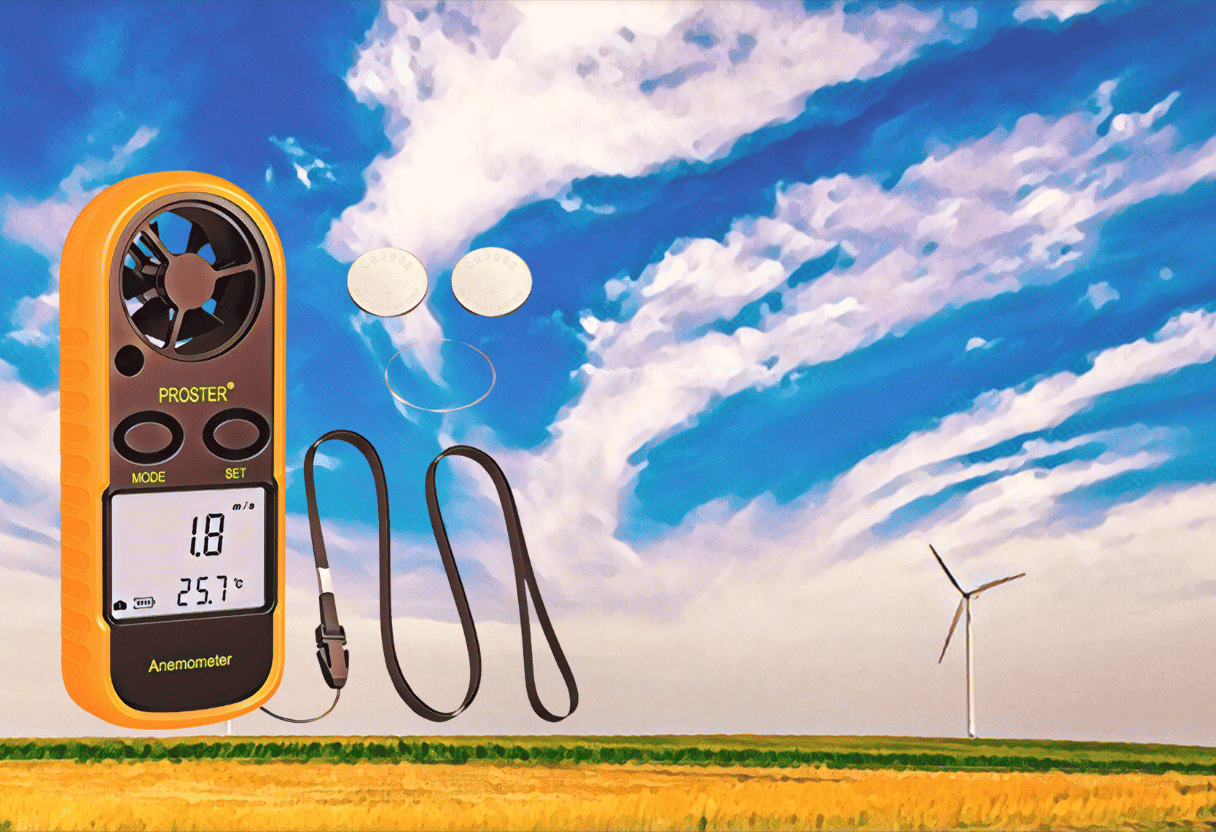Considering an upgrade to your outdoor gear with a handheld anemometer?
The Proster Handheld Anemometer might just be what you need. This device has proven to be a reliable companion on my recent sailing trip, offering precise wind speed measurements with the added convenience of portability.
Its compact design and lightweight nature make it an effortless addition to any outdoor adventure kit.
Well, we’ll be going over:
- How does the Proster Handheld Anemometer stand out in terms of design and functionality for outdoor activities?
- What are the key features that make this anemometer a valuable tool for enthusiasts of activities like sailing, surfing, and more?
- Given its simplicity and focus on core functions, does the Proster Anemometer provide enough value for its price point?
With the Proster Handheld Anemometer, mastering the elements becomes a more informed endeavor.
Let’s dive in.
Quick Review
For an enthusiast of outdoor activities like sailing, surfing, or shooting, the Proster Handheld Anemometer deserves your attention. My experience suggests that it effectively balances ease of use with accurate, quick measurements.
Considering its thoughtful design choices and the value it offers, this anemometer is a solid buy.
Ready to measure the wind with confidence? Click here to purchase the Proster Handheld Anemometer and become master of the elements on your next outdoor adventure.
Overview of the Proster Handheld Anemometer Wind Speed Meter
In my hands, the Proster handheld anemometer felt compact and notably lightweight, making it a breeze to carry on outdoor adventures. My first impression was its bright orange casing that was hard to miss, even when I was out on the water or trekking. As I flipped on the large LCD display, the backlight was a handy feature, particularly when I needed to check wind conditions as the light got low.
Measuring wind speed was straightforward with the device offering readings in various units including m/s, Km/h, and knots, among others. It was useful to have the ability to switch between current, maximum, and average wind speed modes depending on what I was monitoring. I was also impressed with its added function of measuring wind temperature, something not always found in standard anemometers, its usually in home weather stations.
Accuracy is key with instruments like these, and while I noticed some reviews pointing out discrepancies, my experience found the readings to be quite reliable for recreational use. However, I did echo the sentiment of some users regarding the coin battery; a more common battery type would be preferable for easier replacement. Nonetheless, for kite flying, sailing, or even just educational purposes, this gadget proved to be both practical and weather-resistant. Its performance was consistent each time I took it out, and although no tool is without its flaws, the Proster anemometer served its purpose well for the price point.
Key Features
In the midst of using this nifty piece of equipment, I found myself appreciating its thoughtful design and features. Let’s navigate through some of the aspects that make this anemometer stand out for outdoor enthusiasts like me, as well as those who need precise environmental measurements.
Compact & Lightweight Design
Using the anemometer during a recent sailing trip, I was struck by how unobtrusive it was. Weighing a mere 50 grams, I could almost forget I had it in my pocket. The sleek 4.13 x 1.57 x 0.71-inch device didn’t add any weight to my gear, and the vibrant orange color made it easy to spot in a cluttered backpack.
Versatile Wind Speed Measurements
One aspect I can’t gloss over is the anemometer’s capability to gauge wind speed in various units: m/s, Km/h, ft/min, Knots, and mph. It displays wind speed on both a digital scale and a Beaufort bar graph which provided a quick, at-a-glance reading when I was busy managing my sails. The measurement range of 0-30m/s means it’s suitable for even high-wind sports like kite flying.
Temperature Reading with Wind Chill Factor
This tool doesn’t just stop at wind speed; it gives a temperature readout from -10 to 45℃ (14-113℉) inclusive of wind chill, which came in handy on a frosty morning out on the lake. This information helps in assessing the comfort level and potential risk of hypothermia when out in the elements.
User-Friendly LCD Display
Even as the sun started to set, I had no trouble reading the measurements, thanks to the anemometer’s large, backlit LCD display. Being able to toggle between auto and manual power off preserved battery life, and when it came to night-time usage, the backlight was a welcome feature.
In summarizing my experience, I’d argue that the Proster Anemometer merges convenience with functionality. Its light build, comprehensive wind metrics, and easy-to-read display play well into the needs of anyone with a keen eye on the weather.
While I found the temperature range to be adequate for my outings, users in extreme climates might need a wider range. Nonetheless, predicting conditions on my adventures has been a breeze with this anemometer.
Pros and Cons
Pros
After getting my hands on the Proster Anemometer, I found its portability to be a significant advantage. It’s small enough to fit in a pocket, making it extremely handy for outdoor activities like sailing and kite flying. Another upside is its ease of use; the learning curve is minimal, so you can start getting readings right away. The backlight on the LCD display is a thoughtful feature – it comes in handy during low-light situations. Additionally, the device offers multiple wind speed readings, like max and average speed, that are easily accessible, which is useful for quick assessments in various conditions.
Cons
However, there are a few disadvantages worth mentioning. Firstly, some users might find the device smaller than expected, though the dimensions are clearly stated. Battery choice is another minor inconvenience; it uses coin-type batteries, which aren’t as readily available as AAA or AA types. While it does its job well, there’s some feedback suggesting that the accuracy of both the wind speed and temperature measurements might not meet professional standards, with a stated variance in the accuracy that could be significant depending on the application. Finally, durability could be a concern, as there have been isolated instances of the Proster Anemometer failing after limited use, though these might be exceptions rather than the rule.
Performance in Outdoor Activities
After recently taking the Proster Anemometer on a hiking trip, I can share some firsthand insights into its performance. Holding this lightweight device against the gusty mountain winds, it promptly registered the wind speed and chill, proving invaluable for assessing our need for extra layers. The winds were inconsistent, but the anemometer’s ability to give current, maximum, and average readings allowed me to paint a detailed picture of the day’s conditions.
I appreciated the large LCD backlight when checking readings as dusk fell, a feature that became even more useful as visibility lessened. Despite its compact size, the device feels sturdy – a good companion for outdoor types who worry about gear durability. However, I noticed the fine print – the device operates best with humidity levels at or below 90%, so extreme damp climates might affect its accuracy.
In summary, for outdoor enthusiasts who require immediate, precise measurements of wind and temperature, the Proster Anemometer holds its own. It’s easy to see why it’s a popular choice for a range of activities from sailing to kite flying. The ease of use and the reliability it offered during my outing were commendable, though I’d exercise caution in very humid environments.
Ease of Use for Education and Learning
As an educator always on the lookout for practical tools to support outdoor learning, I found the Proster Anemometer to be a surprisingly straightforward device for students to grasp. Whether calculating wind speed for a physics project or understanding weather patterns in geography, its user-friendly interface allowed even the less technically inclined students to obtain accurate readings with minimal instruction. The clear LCD display, enhanced by a backlight, is a true boon for field trips where lighting conditions vary.
However, there’s a slight learning curve when it comes to interpreting the Beaufort wind scale bar graph, especially for younger students. But once they get the hang of it, it becomes second nature. The compact size is also a double-edged sword: it’s wonderfully portable, fitting into a jacket pocket with ease, but for those with larger hands or limited dexterity, it might present a challenge.
One criticism some of my students pointed out is the use of coin batteries; they can be cumbersome to replace and aren’t as commonly available as AA or AAA sizes. Despite this, the overall feedback was positive. The students appreciated how quickly the device responded when measuring both wind speed and temperature—factors that are critical when conducting experiments that require prompt data logging.
Customer Reviews
I’ve recently had the chance to use the Proster Anemometer and dive into what other users think about this handy gadget. With an overall rating of 4.1 out of 5 from over 3,400 ratings, it’s clear it has been well-received by many. Users praise its compactness, noting that it’s light and easy to carry around, which is perfect for outdoor activities like sailing or fishing. The ease of use also comes up frequently—it’s an intuitive device that doesn’t require a steep learning curve.
However, it’s not without its drawbacks. Some users have pointed out that the accuracy could be improved, specifically mentioning that the device’s tolerance could be tighter for both wind speed and temperature. Battery choice is another point of contention; users would prefer more standard batteries over coin cells. On the flip side, I found the device to be quite reliable when monitoring wind conditions during my outdoor excursions.
A few customers encountered issues with their units, but it’s encouraging to see mentions of the seller stepping in with free replacements when necessary. One review, in particular, highlighted a turnaround experience after an initial mishap, which speaks volumes about customer service.
Despite the few criticisms, the general consensus among customers is that this anemometer is a practical tool for its price point, providing sufficient functionality for casual use in various outdoor settings.
Conclusion
After spending some time with the Proster Anemometer, I’ve appreciated how compact and portable it is. It’s light enough to slip into a pocket, making it a practical tool for outdoor enthusiasts. In terms of ease of use, it’s straightforward to operate, which is useful for quick wind checks before outdoor activities like sailing and kite flying.
However, the accuracy does come into question with a margin of error that could be significant for those requiring precise measurements. Moreover, the battery type isn’t the most convenient, as coin cells are not as commonly available as AA or AAA batteries. From an everyday practicality standpoint, the Proster Anemometer performs well for casual monitoring, yet for professional or critical applications, the accuracy might not meet all needs. When all is said and done, it’s a decent device that gets the job done for general use.
Frequently Asked Questions
How accurate are Proster handheld anemometers compared to professional-grade models?
In my experience, the Proster anemometer provides commendable accuracy when gauged against professional-grade devices. Although it’s not as precise as some of the high-end equipment used in meteorological research, it performs reliably for its intended uses, such as outdoor sports and HVAC evaluations. Users should note that the stated accuracy for wind speed is within ±5%, which is satisfactory for non-scientific applications.
Can the Proster anemometer be used effectively for HVAC system evaluations?
Definitely, the Proster anemometer can be quite effective for HVAC system evaluations. It allows you to measure airflow in various units, like m/s and ft/min, which is particularly useful for assessing the performance of vents and ducts. From personal use, I found that it’s compact enough to handle easily and provides a quick response, facilitating efficient HVAC checks.
What is the procedure for powering down the Proster handheld anemometer after use?
To power down the Proster anemometer, the process is straightforward. After utilization, it can be manually switched off by pressing and holding the power button. It also has an auto power-off feature for conserving battery life if it’s not used for a period of time, a convenience I appreciate when I’m out in the field and might forget to turn it off.
Are there any online tutorials available for using the Proster anemometer?
Yes, online tutorials are available for the Proster anemometer. While the device is intuitive enough to pick up and use without much instruction, new users or those looking to leverage more advanced features can benefit from various online resources – videos and articles – that guide through the nuances of wind speed and temperature measurements.
What features differentiate the Proster anemometer from other handheld wind speed meters on the market?
This device stands out with its user-friendly design featuring a large, backlit LCD display for easy viewing in dark environments, which I appreciate during early morning fishing trips. The integration of wind chill indication and an external thermistor provides added value to outdoor enthusiasts. Its compact, lightweight design and the inclusion of a Beaufort wind scale bar graph also distinguish it in the market.
How does the calibration process for a Proster handheld anemometer work?
From my understanding, the calibration process for the Proster anemometer is designed to ensure accuracy and usually must be undertaken in a controlled environment. However, for the average user, the device comes pre-calibrated. Instructions for recalibration—if necessary—are detailed in the user manual, and I would recommend seeking professional assistance to ensure the integrity of the readings if recalibration is needed.







